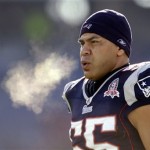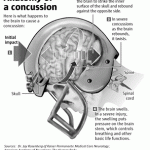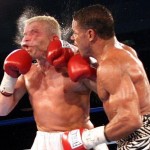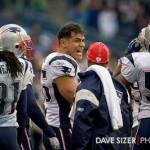When Injured Brains Speak
By Daniel R. Morrison and Monica J. Casper
Last year in TFW, we wrote about the gendered aspects of traumatic brain injury (TBI), noting stark differences between men’s experiences as aggressors in combat and on the playing field and women’s experiences as targets of intimate violence. In the wake of Junior Seau’s suicide and the initial announcement by his family that his brain would be donated for research purposes, the injured brains of athletes and the sports that damage them are again dominating the headlines. Today, we’re focused on cultural and social forces–including football–that produce disability and death. Of special importance here is the role of brain science and the new pathologies “found” when the brains of dead athletes speak.
On May 2, 2012, former NFL linebacker and San Diego Charger Junior Seau was found dead inside his Oceanside, California home, victim of a self-inflicted gunshot wound to the chest. He was 43 years old and the eighth player from the 1995 Chargers Super Bowl team to die. A towering presence, Seau intimidated opposing quarterbacks and delivered crushing hits throughout his career. His death has been ruled a suicide, although no note was found at the scene. Seau’s reasons for ending his own life may never be known; he was widely reported to be a happy, charming person in retirement, and friends and family members were “shocked” by his death despite an alleged previous suicide attempt.
Just over a year ago, former Chicago Bears player Dave Duerson also shot himself in the chest, delivering a lethal blow, and requested posthumously that his brain be donated to research, specifically to the Boston University Center for the Study of Traumatic Encephalopathy. Like Duerson, Seau’s decision to aim a gun at his chest and not at his head has caused speculation that he deliberately avoided damaging his brain so that it could be donated after his death, although the brain’s fate and destination are currently undecided. Seau’s much-publicized death has reopened the sports world’s concern over the short- and long-term consequences of repeated high-speed, high-impact blows to the head sustained during football games and practices.
The media is particularly focused on a condition called chronic traumatic encephalopathy (CTE), a diagnostic category whose discovery was made possible, in part, by postmortem examination of donated brains. (It should be noted that football is not the only sport under review; hockey players, boxers, and soccer players also experience high rates of brain injury.) CTE is associated with concussions and most often discussed in the context of boxing, where powerful blows to the head are common. According to Dr. Ali Mohamadi, writing in the online publication SBNation.com:
It is notable that Seau’s was the third suicide among former professional football players in the past 15 months, and the previous two – former safeties Dave Duerson and Ray Easterling – were thought to have suffered from chronic traumatic encephalopathy (CTE) acquired over their years in the NFL. And as researchers continue to make progress in their understanding of CTE — a degenerative brain condition linked to head trauma that can lead to memory impairment, loss of impulse control, depression, and dementia — questions continue to mount over what can be done to curb its rising incidence.
When masculinity and violence are conflated, as David Leonard notes today in TFW, soldiers, women and children, and athletes of all ages and genders are put at risk for traumatic injuries to brain and body. The need to be tough, to play through pain, is interpreted as showing resilience, while mockery of others’ weaknesses permeates sports at all levels; hypermasculinity is part and parcel of success on the field and off. Junior Seau was well known for his exuberant celebrations after a big hit. His skill, drive, and passion for the game made him an extremely popular player in a twenty-year career at San Diego, Miami, and New England.
For readers of TFW, Brandon Marshall’s thoughts on masculinity, emotion, power, and toughness will likely resonate. Marshall draws a clear line between the culture of masculinity in sports (something Michael Messner, among other scholars, knows well) and mental illness. Discussing children’s early socialization into gender, Marshall notes that we teach our boys not to show weakness or share emotions, except to be strong and tough. Because mental illness remains stigmatized, athletes with CTE (like soldiers with PTSD), or anyone suffering from depression and other mental health problems, face barriers to seeking help.
Marshall sought help for his own struggles and found support:
In therapy, I learned how to express my emotions and talk about my problems, then apply it to my real life. I had to work through my entire belief system, train myself how to think, not what to think, and let go of the things that had me in bondage…
Can you imagine how this presents itself even more so in football players? …
In sports, those who show they are hurt or have mental weakness or pain are told: ‘You’re not tough. You’re not a man. That’s not how the players before you did it.’
Someone like Junior Seau.
So your perception of a man or player gets distorted.
Focusing more on this issue, we see more and more professionals doing research on the brain and head trauma in retired athletes. I respect their science and their research on CTE (chronic traumatic encephalopathy) and how they think it might be associated with depression and dementia, but we can’t recognize CTE until the autopsy.
Young football players admire Seau for putting his body on the line for the win: to sack the quarterback and disrupt offenses with his speed and power. Still, nearly 1,300 former NFL players are suing the league, claiming that the NFL failed to warn them about the dangers of repeated concussions and the risks of long-term brain disease. According to a recent report on the case, the players:
… are arguing that there is a duty to warn about the effects of concussions and that the NFL was unreasonable in carrying out this duty. They argue that the League had an obligation to disclose that concussions might cause long-term brain damage and that the League didn’t protect its players from this long-term damage. This question goes to the scope of a duty to warn. Obvious risks do not create a duty, but the non-obvious effects of those risks might be so important as to justify creating a duty.
The inherent risks of injury are well known to players, coaches, and the NFL, and indeed have contributed to the “individual choice” responses that David Leonard critiques. Because inherent risks are so obvious, no one needs to be warned about their danger. But players are arguing that the NFL created a duty to protect players when it started the Mild Traumatic Brain Injury Committee (MTBIC) in 1994. This committee was formed to investigate the effects of concussions and communicate its findings publicly. Although studies had confirmed a link between concussion and emotional disturbances in later life, the NFL did not change its rules governing concussion until 2009. Critics suggested a conflict of interest, given that team doctors, some of whom were accused of minimizing evidence, were members of the NFL Concussion Committee.
Kurt Warner, Super Bowl champion quarterback, two time NFL MVP, and Christian culture icon, has recently said that he would prefer that his sons not play football. Immediately criticized for his statement, former players said that his comments gave people a bad impression of a great game. Warner clarified that he loves football, but not the violence of the sport. Highlighting his experience in the NFL, and the fact that one of his children lives with the effects of a traumatic brain injury, Warner focuses our attention on the fact that concussions are a serious and potentially life-threatening concern for athletes. But he also raises the stakes by identifying the pressure athletes face to return to the field before their concussions are fully healed.
Without explicitly naming hegemonic masculinity as a major source of pressure to return to action, Warner indicates its effects:
In a world where perception is reality, you can imagine the pressure in professional sports to get back on the field. The pressure can be personal in that a player doesn’t want to let down his teammates by sitting out a game when everyone says he is cleared to play. The pressure can be peer driven. The ambiguous looks and feelings one derives from coaches and players that say, “you need to be on the field for us”. Whether these are real or just thought up doesn’t really matter, because either way they weigh upon an athletes mind. Then there is the pressure for many marginal players that if they don’t get out there and play their job will be given to another person and their career could be over. But, probably the most demanding pressure is that those playing football are supposed to be TOUGH. And we all know that tough means having the ability to play through injury. Those that place their pain aside and lineup next to their teammates for battle gain instant recognition from their team. Nobody in this business wants to be recognized by his teammates/organization as ‘soft’…
Here sit your two options: To feel on one hand that you are letting down those closest to you off the field, but appeasing the powers that be (org, coaches, teammates) or to feel as if you are letting down the powers that be, but making the best decision for you personally both immediately and for the future. Can you understand the pressure or difficulty of making this decision?
In the intense, heteronormative, and hegemonically masculine spaces of the field, diamond, and ring, the pressure to perform may lead to unnecessary risk-taking, repeated concussions, CTE, and death. It is easy to read the above comments about TOUGHness and softness as codes for masculine and feminine gender performance, on the field of the most masculine team sport today. The easy dichotomy between masculinity and femininity on display here shows that the gender binary structures the thinking and action of teammates, coaches, staff, owners, and the business of professional football. Warner’s willingness to speak out on this issue, and to praise the NFL’s new protocols which prohibit anyone showing signs of concussion from being allowed back into a game, is certainly welcome.
Just this week, NPR’s Frank Deford reminded listeners of the nearly 5 million young people who play football below the college level. How much violence, how many concussions, and how much damage to length and quality of life is acceptable, given what we know, and have known, about the dangers? Deford stated:
The very brutal nature of football is what makes it so uniquely popular to Americans, but how can you distill the violence from the game and sustain its enchantment? And if it remains so dangerous a sport — never mind liability — when will we reach a point, ethically, compassionately, when some major school, some conference, some high school association is the first to say: We’re sorry, but as much as we love to watch football, we can’t any longer countenance putting our boys in jeopardy, playing this brain game for our vicarious amusement.
Who benefits from a hegemonically masculine game like football? Certainly, the owners and players benefit financially, advertisers win big during televised games, and fans benefit through enjoyment of a uniquely American spectacle. Moreover, football is evocative of that other spectacle, war–also a stronghold of hypermasculinity.
But as feminist scholars, we suggest an “unpacking” of the relationships among hypermasculine spectacle, capitalism, and brain damage. We should be asking, for example, why a sport that routinely disables and sometimes kill people is so lucrative and popular. We should also be asking why we’re investing so much money in downstream practices, like high-tech research on donated brains, rather than on upstream practices of risk prevention. And perhaps we should be asking the most important question of all: why do we enjoy it so much when men brutalize and damage each other for our viewing pleasure?
_______________________________________________
 Daniel R. Morrison is a doctoral candidate in the department of sociology at Vanderbilt University. His research interests include science, technology, and medicine; symbolic interaction; culture; and biomedical ethics. His dissertation is a qualitative study of the development and use of brain implant technologies. He will join the faculty of Pepperdine University in August of 2012.
Daniel R. Morrison is a doctoral candidate in the department of sociology at Vanderbilt University. His research interests include science, technology, and medicine; symbolic interaction; culture; and biomedical ethics. His dissertation is a qualitative study of the development and use of brain implant technologies. He will join the faculty of Pepperdine University in August of 2012.









0 comments